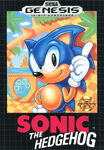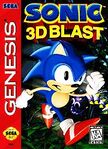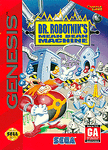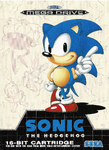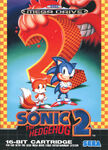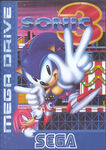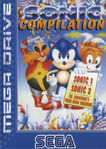(Adding categories) |
|||
| Line 187: | Line 187: | ||
{{Video game systems}} |
{{Video game systems}} |
||
[[Category:Sega systems]] |
[[Category:Sega systems]] |
||
| + | [[Category:Systems]] |
||
Revision as of 13:01, 1 December 2013
Information in this article is about real-life people, companies, and objects, which do not relate to the in-universe Sonic series. |
|
If you are looking for the portable version, see Sega Nomad
Genesis logo
Mega Drive logo
Sega Genesis
A Sega Mega Drive II.
The Sega Mega Drive (メガドライブ Mega Doraibu?) is a 16-bit video game console released by Sega in Japan in 1988, North America in 1989, and the PAL region in 1990. It was sold under the name Sega Genesis in North America as Sega was unable to secure legal rights to the "Mega Drive" name in that region. The Mega Drive was Sega's third home console and the successor to the Sega Master System.
The Mega Drive is part of the fourth generation era of consoles, and the first of its generation to achieve notable market share in Europe and North America. It was a direct competitor of the TurboGrafx-16 (which was released one year earlier) and the Super Nintendo Entertainment System (which was released two years later). The Sega Mega Drive began production in Japan in 1988 and ended with the last new game being released in 2002 in Brazil.[1]
With a lifespan of fourteen years and 41.9 million units sold, it became Sega's most successful console. The console has a legacy with certain games available on the console being offered as downloads to be played on newer consoles, fan translations[2] and indie game development.
Sonic games
- Sonic the Hedgehog
- Sonic the Hedgehog 2
- Sonic the Hedgehog 3
- Sonic & Knuckles
- Sonic the Hedgehog 3 & Knuckles
- Knuckles the Echidna in Sonic the Hedgehog 2
- Blue Sphere
- Sonic Classics
- Sonic 3D Blast
- Sonic Spinball
- Dr. Robotnik's Mean Bean Machine
- Flicky
- Wacky Worlds Creativity Studio
- 6-Pak
Sonic Generations Classic Era
Sonic the Hedgehog, Sonic the Hedgehog 2 and Sonic the Hedgehog 3 & Knuckles were in Sonic Generations for the Classic era.
Characters Introduced
Box Art Gallery
United States
United Kingdom
Japan
History
Although the Sega Master System was a success in Europe, and later also Brazil, it failed to ignite much interest in the North American or Japanese markets, which, by the mid-to-late 1980s, were both dominated by Nintendo's large market shares.[3][4][5] Meanwhile in the arcades, the Sega System 16 had become a success. Hayao Nakayama, Sega's CEO at the time, decided to make its new home system utilize a similar 16-bit architecture.[6] The final design was eventually also used in the Mega-Tech, Mega-Play and System-C arcade machines. Any game made for the Mega Drive hardware could easily be ported to these systems.[7]
The first name Sega considered for its console was the MK-1601, but it ultimately decided to call it the "Sega Mega Drive". The name was said to represent superiority and speed, with the powerful Motorola 68000 processor in mind.[8] Sega used the name Mega Drive for the Japanese, European, Asian, Australian and Brazilian versions of the console. The North American version went by the name "Genesis" due to a trademark dispute.[9]
Launch
The Mega Drive was released in Japan on October 29 1988,[10] almost exactly a year after the NEC PC Engine.
In 1987, Sega announced a North American release date for the system (under the name of Sega Genesis) of January 9 1989.[11] Sega initially attempted to partner with Atari Corporation for distribution of the console in the US, but the two could not agree to terms and Sega decided to do it themselves.[12] Sega was not able to meet the initial release date and United States sales began on August 14, 1989 in New York City and Los Angeles. The Genesis was released in the rest of North America later that year.[13]
The European release was on November 30, 1990. Following on from the European success of the Sega Master System, the Mega Drive became a very popular console in Europe. Unlike in other regions where the Nintendo Entertainment Systeam had been the dominant platform, the Sega Master System was the most popular console in Europe at the time. In the United Kingdom the most well known of Sega's advertising slogans was "To be this good takes AGES, to be this good takes SEGA". Some of these adverts employed adult humor and innuendo with sentences like "The more you play with it, the harder it gets" displayed with an illustration of the waggling of a joystick.[14] A prominent figure in the European marketing was the "Sega Pirate", a talking one-eyed skull that starred in many TV adverts with a generally edgy and humorous attitude. Since the Mega Drive was already two years old at the release in Europe, the many games available at launch were naturally more in numbers compared to the launches in other regions. The ports of arcade titles like Altered Beast, Golden Axe and Ghouls 'n Ghosts, available in stores at launch, provided a strong image of the console's power to deliver an arcade-like experience.[15] The arrival of Sonic the Hedgehog in 1991 was just as successful as in North America, with the new Sega mascot becoming popular throughout the continent.[15]
In Brazil, the Mega Drive was released by Tec Toy in 1990, only a year after the Brazilian release of the Sega Master System. Tec Toy also ran the Internet service Sega Meganet service in Brazil as well as producing games exclusively for the Brazilian market.[16] On December 5 2007, Tec Toy released a portable version of Mega Drive with 20 built-in games.[17][18]
Console wars
The Sega Mega Drive initially competed against the aging 8-bit NES, over which it had superior graphics and sound. Despite this, the Mega Drive was all but ignored in Japan as soon as it was launched. Some positive coverage came out of magazines Famitsu and Beep!, but Sega shipped only 400,000 units in the first year.[9] In order to sell more units, Sega tried some risky moves, including creating an online banking system and answering machine called the Sega Answer[19] and several peripherals and games.[9] The Mega Drive remained a distant third in Japan behind Nintendo's Super Famicom and NEC's PC-Engine throughout the 16-bit era.[20]
New Sega of America CEO Michael Katz instituted a two-part approach to build sales in that region. The first part involved a marketing campaign to challenge Nintendo head-on and emphasize the more arcade-like experience available on the Genesis, summarized by the slogan "Genesis does what Nintendon't".[21][22] The second part, since Nintendo owned the console rights to most arcade games of the time, involved creating a library of instantly-recognizable titles by contracting with celebrities and athletes to produce games using their names and likenesses; Pat Riley Basketball, Arnold Palmer Tournament Golf, James 'Buster' Douglas Knockout Boxing, Joe Montana Football, Tommy Lasorda Baseball, Mario Lemieux Hockey, and Michael Jackson's Moonwalker all stemmed from this initiative.[23][24] Nonetheless, it had a hard time overcoming Nintendo's ubiquitous presence in the consumer's home.[25]
Sega CEO Hayao Nakayama, fearing a second market failure soon after the Master System, hired Tom Kalinske to replace Katz in mid-1990. Although Kalinske initially knew little about the video game market, he learned quickly and surrounded himself with industry-savvy advisers. A believer in the razor and blades business model, he developed a four-point plan: cut the price of the console; create a US-based team to develop games targeted at the American market; continue and expand the aggressive advertising campaigns; and replace the bundled game with a new title, Sonic the Hedgehog.[25] The Japanese board of directors asked "Are you out of your mind?",[26] but Nakayama approved all four points. Magazines praised Sonic as one of the greatest games yet made, and Sega's console finally took off as customers who had been waiting for the Super NES decided to purchase a Genesis instead.[25] Nintendo's console would debut against an established competitor, while NEC's TurboGrafx-16 was left out and NEC soon pulled out of the market.[27]
Sega began 1992 with a number of advantages: a 55% to 45% market share over the Super NES, a lower price, and a tenfold advantage in number of games.[28] Sega's advertising continued to position the Genesis as the "cooler" console,[28] and coined the term "Blast Processing" to suggest that the Genesis was capable of handling games with faster motion than the SNES.[29] A Sony focus group found that teenage boys would not admit to owning a Super NES rather than a Genesis.[30] Neither console could maintain a definitive lead in market share for several years.
In Europe, the Mega Drive maintained support through 1998. It outsold all other consoles, including the Sega Saturn, in later years.[10] Brazil also saw success with the Mega Drive, where it held 75% of the market share.[10]
Add-ons
In early 1991, Sega announced the Mega-CD for release in Japan in late 1991 and in North America (as the Sega CD) in 1992. While the Mega Drive add-on did contain a faster CPU and some enhanced graphics capabilities, the main focus of the device was to expand the size of games: cartridges of the day typically contained 8 to 16 megabits of data, while a CD-ROM disk would hold 640 megabytes (5120 megabits). Sega of Japan, partnering with Sony, refused to consult with Sega's American division until the project was completed—Sega of America had to assemble parts from various "dummy" units to obtain a working prototype.[31] While it became known for several games, especially Sonic CD, the expansion only sold 6 million units worldwide.[32]
At June 1994's Consumer Electronics Show, Sega presented the 32X as the "poor man's entry into 'next generation' games."[33] Although some blame Sega of America for developing this failure,[32] the 32X was originally conceived as an entirely new console by Sega of Japan.[34] Sega of America R&D head Joe Miller convinced Sega of Japan to strengthen the console and convert it into an add-on to the existing Genesis, but they would not make it a competitor to the forthcoming Sega Saturn. Although this add-on contained two 32-bit CPU chips and a 3D graphics processor, it failed to attract either developers or consumers as the superior Saturn had already been announced for release the next year. Originally released at US$159, Sega dropped the price to $99 in only a few months and ultimately cleared the remaining inventory at $19.95;[34] only 200,000 units were sold.[32]
32-bit era and beyond
By the end of 1995, Sega was supporting five different consoles and two add-ons: Saturn, Genesis, Game Gear, Pico, Sega CD, 32X and Master System in some South American markets. As the Saturn was leading Sony's PlayStation in Japan while the Mega Drive was never successful there, Sega of Japan CEO Hayao Nakayama chose to discontinue the Mega Drive. While this made perfect sense for the Japanese market, it was disastrous in North America: the market for Genesis games was much larger than for the Saturn, but Sega was left without the inventory or software to meet demand. In comparison, Nintendo concentrated on the 16-bit market and reported the most lucrative holiday season in the industry.[35] It also undercut the Sega of America executives; CEO Tom Kalinske, who oversaw the rise of the Genesis in 1991, grew uninterested in the business and resigned in mid 1996.[36]
In 1997, Sega licensed the Mega Drive to Majesco so that its could re-release the console.[37] Majesco began re-selling millions of formerly unsold cartridges at a budget price together with the second model of the Genesis, until it later released a third version of it. The last commercially licensed release in North America was Frogger, released in 1998.[38]
The Mega Drive was supported until 1997 in Europe, when Sega announced it was dropping support for it.[10] It was discontinued along with its predecessor, the long-lived Sega Master System, to allow Sega to concentrate on its newer console, the Saturn. The Mega Drive's add-ons, the Mega CD and 32X, were also both discontinued at this point, having been the same general failures they were in the other regions.[32]
In Brazil, the Mega Drive never ceased production, though Tec Toy's current models emulate the original hardware. The latest version, called "Mega Drive Guitar Idol", comes with two six-button joypads and a guitar controller with five fret buttons. The Guitar Idol game contains a mix of Brazilian and international songs. The console has 87 built-in games, including some new ones from Electronic Arts, originally cellphone games: FIFA 2008, Need for Speed Pro Street, The Sims 2 and Sim City. In 2008 Chinese company ATGames produced a new Mega Drive compatible console. It features a top-loading cartridge slot and includes two controllers similar to the six-button controller for the original Mega Drive. The console has 15 games built-in, and is region-free, allowing cartridge games to run regardless of their region of origin. ATGames also produces a handheld version of the console. Both machines have been released in Europe by distributing company Blaze Europe. Mitashi, a consumer appliance manufacturer in India, released a version of the Mega Drive called Game-In Xtreme, with a few built in games. Even though the name 'Mega Drive' has never been mentioned, it plays 16-bit Mega Drive cartridges. In North America during 2009, ATGames released two new officially licensed Genesis consoles: the Firecore and the Gencore. In addition to that, two new officially licensed Genesis portables also made their debut; the Retrogen, and the Genmobile. The Firecore can play newly developed "Truecolor" games. All the consoles ship with twenty official Genesis games built in (with the exception of the Retrogen which, instead, is shipped with twenty homebrew games).
Emulation
In 2004, there came a trend toward plug-and-play TV games, and Radica Games released licensed, self-contained versions of the Sega Mega Drive in both North America (as the Play TV Legends Sega Genesis)[39] and Europe (as the Sega Mega Drive 6-in-1 Plug 'n' Play), which contain six popular games in a small control box, with a permanently connected control pad. It does not have a cartridge slot, and thus is a dedicated console.[40]
The GameTap subscription gaming service includes a Mega Drive emulator, and has several dozen licensed Mega Drive games in its catalog.[41] The Console Classix subscription gaming service also includes an emulator, and has several hundred Mega Drive games in its catalog.[42]
During his keynote speech at the 2006 Game Developers Conference, Nintendo president Satoru Iwata announced that Sega will make a number of Genesis/Mega Drive titles available to download on the Wii's Virtual Console.[43] These games are now available along with other systems' titles under the Wii's Virtual Console.[43] The 16-bit Sega selections available on the Virtual Console at launch were Altered Beast and Sonic the Hedgehog. There are also selected Mega Drive titles on the Xbox 360 such as Sonic the Hedgehog and Sonic 2.
Master System compatibility

Sega Power Base Converter
One of the key design features of the console is its backwards compatibility with Sega's previous console, the Sega Master System. The 16-bit design is based upon the 8-bit design, albeit enhanced and extended in many areas. In order to achieve backwards compatibility, the Master System's central processor and sound chip (the Zilog Z80[8] and SN76489 respectively) are included in the Mega Drive, and the Mega Drive's Video Display Processor (VDP) is capable of the Master System's VDP's mode 4 (though it cannot run in modes 0, 1, 2, or 3).
As the cartridge slot is of a different shape, Sega released the Power Base Converter, a separate device that sits between a Master System cartridge and the Mega Drive's cartridge slot. The Power Base Converter does not contain any Master System components, instead functioning as a pass-through device. The converter contains a top slot for cartridge-based games along with a front slot for card-based games, as well as the 3-D glasses adapter. When a Master System game is inserted, the system puts the Z80 in control, leaving the Mega Drive's main 68000 processor idle.[8]
In Japan the device is known as the "Mega Adapter". The PAL variant is called the "Master System Converter" in mainland Europe.[44]
The Power Base Converter is not fully compatible with the redesigned Mega Drive 2. A second version, the "Master System Converter II", was released to address this problem. This second version adapter was produced in a far smaller quantity and only released in Europe.[8]
The only game which does not work with this device is F-16 Fighting Falcon.[45]
Peripherals
The original three-button controller, marked with the Genesis logo.
The standard Mega Drive controller features three main buttons and a "start" button usually used for pausing mid-game. The controller itself has a distinctive rounded shape.[46] Sega later released a six-button version which is slightly smaller and features three more face buttons, similar to the design of buttons on arcade fighting games.[46]
The Sega Mega-CD became available in 1991, 1992 and 1993 in Japan, North America, and Europe respectively.[47][48] It plugs into the side of the Mega Drive and sits underneath the console (later models of the Mega CD sit alongside the console) and provides access to CD games as well as allowing the user to play music CDs.[8]
The Sega 32X allows the user to play technically superior 32-bit games on the Mega Drive. It was released in 1994 in Japan (after the release of the Sega Saturn in that region) and North America and 1995 in Europe. The 32X plugs into the Mega Drive's cartridge slot and the game cartridges are then plugged into the 32X.[8]
A number of other peripherals for the Mega Drive were released that add extra functionality. The Menacer Light Gun was developed in response to the Super Scope for the SNES and is only compatible with the Menacer 6-game cartridge and a few other games.[49] The Sega Mouse and Sega Mega Mouse were also released for the Mega Drive,[50] the latter being available in North America while the other served the Japanese and European markets. A foam-covered bat called the BatterUP and the TeeVGolf golf club were both released for the Mega Drive and SNES and provide support for similar games.[50][51] One of the most unsuccessful peripherals released was the Sega Activator, an octagonal device that lays flat on the floor and reads a gamer's physical movements as he/she would trigger infrared laser beams that translate the movement to react on screen.[52] As well the official Mega Drive peripherals, the console is also compatible with Sega Master System accessories through use of the Power Base Converter.[53][10]
Both Electronic Arts (EA) and Sega released multitaps for the system to allow more than the standard two players to play at once.[54] Initially, EA's version, the 4-Play, and Sega's adapter, the Team Player, only supported each publisher's own titles. Later games were created to work on both adapters. Codemasters also developed the J-Cart system, providing two extra ports with no extra hardware, although the technology came late in the console's life and only featured on a few games.[55]
Technical specifications
CPU
The Sega Mega Drive's CPU is a 16/32-bit Motorola 68000[56] which is a 16 bit microprocessor sitting on a 16-bit-wide data bus. The maximum addressable memory is 16 megabytes (the M68000 is located to the top right of the picture). The 68000 runs at 7.61 MHz in PAL consoles, 7.67 MHz in NTSC consoles.[46] The Mega Drive also includes a Zilog Z80 as the sound CPU.[8]
Video
The Mega Drive has a dedicated VDP (Video Display Processor) for background graphic and sprite control. This is an improved version of the Sega Master System VDP, which in turn is derived from the Texas Instruments TMS9918. Images can be output at 256 pixels (32 tiles) or 320 pixels (40 tiles) across and 224 scan lines (28 tiles) or 240 scan lines (30 tiles) down. The 240-line resolutions are only used on 50 Hz (i.e. PAL) displays, as the extra lines end up in the over-scan of a 60 Hz (NTSC) signal. Instead, NTSC games use the 224-line resolution to free up more vertical blanking time to send more updates to the VDP. Colors are chosen from a total of 512 possible colors; some games used a small amount of flicker to simulate more colors. Graphics consist of up to 80 sprites on screen and 2 background planes. Palettes are stored in color RAM (CRAM) and consist of 16 colors each for a total of 64 colors.[57][54]
Audio
There are two primary sound chips which are both controlled by the Z80; the Yamaha YM2612 Frequency Modulation (FM) chip and the Texas Instruments N76489 Programmable Sound Generator (PSG) chip.[10] The FM sound synthesis IC resembles the Yamaha 2151 (used in Sega's coin-op machines) and the chips used in Yamaha's synthesizers. There are 8 kilobytes of dedicated sound RAM available to the Z80.[57] The Yamaha uses six FM channels, four operators each and runs at 7.67 MHz (7.61 MHz in PAL machines). The use of the digitized audio allows for stereo sound and is output only through the headphone jack on model 1 systems and through AV out on model 2 systems along with mono signal.[8]
Memory
There are 2 KB (KiB) of Boot ROM, which is also known as the "Trademark Security System" (TMSS). When the console is started, it checks the game for certain code given to licensed developers. Unlicensed games without the code are thus locked out, but if a game is properly licensed, the ROM will display "Produced by or under license from Sega Enterprises Ltd."[58]
There are also 64 KB of Main RAM. The Main RAM is part of the M68000 address space (short-word addressing was frequently used). 64 KB of Video RAM are also present,[10] which cannot be accessed directly by CPU and must be read and written via the VDP (Video Display Processor). The Secondary RAM, which consists of 8 KB, is part of Z80 address space and is used as Main RAM in Master System compatibility mode. There are also 8 KB of audio RAM.[10]
Inputs and outputs
Two DE-9M (9-pin male D-connectors) on the front of the console are the controller input ports.[54] The EXT input port is a DE-9F (9-pin female D-connector) that was used with the Meganet modem peripheral, released only in Japan.[54] It exists on all first-model Japanese Mega Drive units, and on early American Genesis and PAL (European, Australasian and Asian) Mega Drive units. The power input is a positive tip barrel connector that requires 9-10 volts DC, or about 0.85-1.2 A, depending on the model. There is also an Expansion input port which is an Edge connector on the bottom right hand side of the console. It is used almost exclusively for connection for the Sega Mega-CD, though it was also used for the Sega Genesis 6 Cart Demo Unit (DS-16) in stores. This port is not present on the Genesis 3 model.[8]
An A/V output, which consists of a DIN connector with composite video, RGB video, and audio outputs, is present on the system.[8] The Mega Drive and the first model Genesis have an 8-pin DIN socket (same as Sega Master System) which supports mono audio only, but the Mega Drive 2, Multimega, and other models have a 9-pin mini-DIN connector with both mono and stereo audio.[8] Stereo audio for the Mega Drive and the first model Genesis were supplied by the headphone jack, which is not present on later models.[8] The RF output is an RCA jack that connects to TV antenna input. It exists on original model European and Asian Mega Drive and North American Genesis only; other models must use an external RF modulator which plugs into the A/V output.[8]
Sega Nomad

The Sega Nomad, basically a portable Genesis.
The Sega Nomad (also called Sega Genesis Nomad or just Nomad) was a handheld game console sold for the North American consumer market which played Mega Drive/Genesis game cartridges. The system was similar to the Japanese Sega Mega Jet, but featured a built-in color screen; the Mega Jet needed a separate monitor. It sold 1 million units. The Nomad was never officially released in PAL territories such as Europe and Australia, though the unit retained its PAL/NTSC switch on the internal board. It was released in Japan after a delay as the Mega Jet was already being sold in Japanese retail stores. The Nomad is one of the few Sega systems that can play most games regardless of region without an adapter. Its codename during development was Project Venus, as per Sega's policy at the time of codenaming their systems after planets.
References
- ↑ http://www.guardiana.net/MDG-Database/Mega%20Drive/Show%20do%20Milh%C3%A3o/
- ↑ http://www.romhacking.net/?platform=11&languageid=12&perpage=30&page=translations
- ↑ Steven L. Kent (2001). The Ultimate History of Video Games: The Story Behind the Craze that Touched our Lives and Changed the World. Roseville, California: Prima Publishing. pp. pp. 303, 360. ISBN 0-7615-3643-4.
- ↑ Pettus, Sam (2004-07-07). Genesis: A New Beginning. www.sega-16.com. Retrieved on 2008-03-06.
- ↑ Planet Dreamcast staff . Sega History. http://www.planetdreamcast.com. IGN Entertainment. Retrieved on 2007-10-18.
- ↑ 8.00 8.01 8.02 8.03 8.04 8.05 8.06 8.07 8.08 8.09 8.10 8.11 8.12 Christoph Bolitz
. Sega Mega Drive information. www.skillreactor.org. Retrieved on 2008-04-01. Cite error: Invalid
<ref>tag; name "sreac" defined multiple times with different content Cite error: Invalid<ref>tag; name "sreac" defined multiple times with different content Cite error: Invalid<ref>tag; name "sreac" defined multiple times with different content Cite error: Invalid<ref>tag; name "sreac" defined multiple times with different content Cite error: Invalid<ref>tag; name "sreac" defined multiple times with different content Cite error: Invalid<ref>tag; name "sreac" defined multiple times with different content Cite error: Invalid<ref>tag; name "sreac" defined multiple times with different content Cite error: Invalid<ref>tag; name "sreac" defined multiple times with different content - ↑ 9.0 9.1 9.2 Szczepaniak, John (September 2006). Retroinspection: Sega Mega Drive. Imagine Publishing. Retrieved on 2007-11-08.
- ↑ 10.0 10.1 10.2 10.3 10.4 10.5 10.6 10.7 Console Database Staff
. Sega Mega Drive/Genesis Console Information. http://www.consoledatabase.com. Console Database/Dale Hansen. Retrieved on 2007-10-18. Cite error: Invalid
<ref>tag; name "ConsoleInfo" defined multiple times with different content Cite error: Invalid<ref>tag; name "ConsoleInfo" defined multiple times with different content Cite error: Invalid<ref>tag; name "ConsoleInfo" defined multiple times with different content - ↑ Sheff, David (1993). Game Over: How Nintendo Zapped an American Industry, Captured Your Dollars, and Enslaved Your Children. New York: Random House. pp. 352. ISBN 0-679-40469-4.
- ↑ Steven L. Kent (2001). The Ultimate History of Video Games: The Story Behind the Craze that Touched our Lives and Changed the World. Roseville, California: Prima Publishing. pp. p. 401. ISBN 0-7615-3643-4.
- ↑ Kent, Steven L. (2001). The Ultimate History of Video Games. Roseville, California: Prima Publishing. pp. 404–405. ISBN 0-7615-3643-4.
- ↑ SEGA'S BIZARRE EARLY 1990S VIZ ADVERTS. http://www.ukresistance.co.uk (2006). Retrieved on 2007-10-20.
- ↑ 15.0 15.1 McFerran, Damien "Damo"
(2007). Hardware Focus - Sega Megadrive /Genesis. http://www.vc-reviews.com. Retrieved on 2007-10-19. Cite error: Invalid
<ref>tag; name "MegaDriveLaunch" defined multiple times with different content - ↑ Tiago Tex Pine (2008-02-26). How Piracy can Break an Industry - the Brazilian Case. Retrieved on 2008-04-14.
- ↑ Donald Melanson (2007-11-13). Brazil's TecToy cranks out Mega Drive portable handheld. Retrieved on 2007-01-23.
- ↑ Luke Plunkett (2007-11-14). Sega: Brazil Gets This Wonderful Portable Mega Drive. Retrieved on 2007-01-23.
- ↑ MattG (2005-08-04). Sega's "Anser" to a Question Nobody Asked. Retrieved on 2008-05-07.
- ↑ Steven L. Kent (2001). The Ultimate History of Video Games: The Story Behind the Craze that Touched our Lives and Changed the World. Roseville, California: Prima Publishing. pp. p. 447. ISBN 0-7615-3643-4.
- ↑ Steven L. Kent (2001). The Ultimate History of Video Games: The Story Behind the Craze that Touched our Lives and Changed the World. Roseville, California: Prima Publishing. pp. p. 405. ISBN 0-7615-3643-4.
- ↑ Orlando, Greg (2007-05-15). Console Portraits: A 40-Year Pictorial History of Gaming. Wired News 22. Condé Nast Publications. Retrieved on 2008-04-08.
- ↑ Steven L. Kent (2001). The Ultimate History of Video Games: The Story Behind the Craze that Touched our Lives and Changed the World. Roseville, California: Prima Publishing. pp. pp. 406–408. ISBN 0-7615-3643-4.
- ↑ Horowitz, Ken (2007-11-20). Behind the Design: Joe Montana Football. www.sega-16.com. Retrieved on 2008-05-11.
- ↑ 25.0 25.1 25.2 Steven L. Kent (2001). The Ultimate History of Video Games: The Story Behind the Craze that Touched our Lives and Changed the World. Roseville, California: Prima Publishing. pp. pp. 424–431. ISBN 0-7615-3643-4.
- ↑ Steven L. Kent (2001). The Ultimate History of Video Games: The Story Behind the Craze that Touched our Lives and Changed the World. Roseville, California: Prima Publishing. pp. p. 428. ISBN 0-7615-3643-4.
- ↑ Steven L. Kent (2001). The Ultimate History of Video Games: The Story Behind the Craze that Touched our Lives and Changed the World. Roseville, California: Prima Publishing. pp. pp. 433, 449. ISBN 0-7615-3643-4.
- ↑ 28.0 28.1 Steven L. Kent (2001). The Ultimate History of Video Games: The Story Behind the Craze that Touched our Lives and Changed the World. Roseville, California: Prima Publishing. pp. pp. 434, 448–449. ISBN 0-7615-3643-4.
- ↑ The Essential 50 Part 28: Sonic the Hedgehog. www.1up.com. Retrieved on 2008-04-21.
- ↑ Steven L. Kent (2001). The Ultimate History of Video Games: The Story Behind the Craze that Touched our Lives and Changed the World. Roseville, California: Prima Publishing. pp. p. 449. ISBN 0-7615-3643-4.
- ↑ Steven L. Kent (2001). The Ultimate History of Video Games: The Story Behind the Craze that Touched our Lives and Changed the World. Roseville, California: Prima Publishing. pp. pp. 450–451. ISBN 0-7615-3643-4.
- ↑ 32.0 32.1 32.2 32.3 Blake Snow (2007-07-30). The 10 Worst-Selling Consoles of All Time. GamePro. Retrieved on 2008-05-20.
- ↑ Steven L. Kent (2001). The Ultimate History of Video Games: The Story Behind the Craze that Touched our Lives and Changed the World. Roseville, California: Prima Publishing. pp. p. 493. ISBN 0-7615-3643-4.
- ↑ 34.0 34.1 Steven L. Kent (2001). The Ultimate History of Video Games: The Story Behind the Craze that Touched our Lives and Changed the World. Roseville, California: Prima Publishing. pp. pp. 493–496. ISBN 0-7615-3643-4.
- ↑ Steven L. Kent (2001). The Ultimate History of Video Games: The Story Behind the Craze that Touched our Lives and Changed the World. Roseville, California: Prima Publishing. pp. pp. 508, 531. ISBN 0-7615-3643-4.
- ↑ Steven L. Kent (2001). The Ultimate History of Video Games: The Story Behind the Craze that Touched our Lives and Changed the World. Roseville, California: Prima Publishing. pp. pp. 535. ISBN 0-7615-3643-4.
- ↑ Sega (Majesco) Genesis 3. www.pelikonepeijoonit.net. Retrieved on 2008-03-06.
- ↑ Game Rankings Recent Releases list of Genesis. CNET Networks, Inc.. Retrieved on 2008-04-03.
- ↑ Play TV Legends Sega Genesis - Radica Games. Retrieved on 2006-09-24.
- ↑ Miles, Stuart . Sega Mega Drive 6-in-1 Plug and play Review. http://www.gamesdog.co.uk. Retrieved on 2007-10-19.
- ↑ GameTap Catalogue. http://www.gametap.com. Retrieved on 2007-10-19.
- ↑ Console Classix Sega Genesis games. Retrieved on 2008-05-15.
- ↑ 43.0 43.1 Template:Cite news
- ↑ Old-Computers.com Staff . Mega Drive II. http://www.old-computers.com. Retrieved on 2007-10-18.
- ↑ Master System Converter Instruction Manual, p. 7.
- ↑ 46.0 46.1 46.2 Michael Drake, Adrian Lees, and Jeffrey Lee
. Pico Drive Mega Drive Background. Retrieved on 2008-04-03. Cite error: Invalid
<ref>tag; name "pd" defined multiple times with different content - ↑ Pettus, Sam (2004-07-15). Sega CD: A Console too Soon. Sega-16. Retrieved on 2008-03-05.
- ↑ Pettus, Sam . Sega CD info. Retrieved on 2008-04-03.
- ↑ John Scalzo (2007-11-19). Zap!: A History of Light Gun Games (Special) @ Gaming Target. Retrieved on 2008-04-03.
- ↑ 50.0 50.1 Vidgame.net . Sega Genesis Peripherals. Retrieved on 2007-10-17.
- ↑ Super NES/Famicom Peripherals. Gamers Graveyard. Retrieved on 2007-07-02.
- ↑ Sega Genesis at Game-Machines.com. www.game-machines.com. Retrieved on 2008-04-03.
- ↑ Barr, Adrienne . Sega Genesis Power Base Converter. Retrieved on 2007-10-18.
- ↑ 54.0 54.1 54.2 54.3 The Sega Mega Drive/Genesis. www.captainwilliams.co.uk. Retrieved on 2008-04-03.
- ↑ Template:Cite news
- ↑ MC68000 Documentation. www.ticalc.org. Retrieved on 2008-04-03.
- ↑ 57.0 57.1
Genesis Collective FAQ. www.genesiscollective.com. Retrieved on 2008-03-06. Cite error: Invalid
<ref>tag; name "genesiscollective" defined multiple times with different content - ↑ Sega Enterprises Ltd. v. Accolade Inc.. digital-law-online.info (1992-10-20). Retrieved on 2008-04-02.
External links
- Sega Mega Drive at Wikipedia, the free encyclopedia
Template:Video game systems

